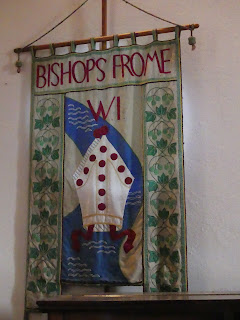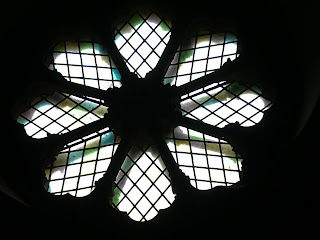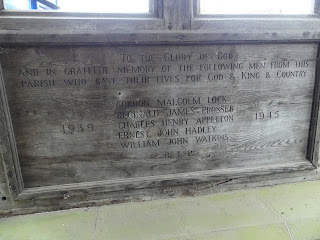Bishop's Frome is a village 5 miles from Bromyard with a population of ~800. It takes its name from the River Frome which flows through the parish. "Frome" is an old Celtic name for river. The "Bishop's" part of the name comes from a Bishop of Hereford who at one time was Lord of the Manor. There was a priest in the village at the time of the Domesday Book in 1086 which suggests there was once a Saxon church on the site of the present church.
The current church building is a mix of Norman and Neo-Norman architecture. The church was restored and the chancel is by R C Carpenter 1847 and the remaining restoration was by F R Kempson in 1860/61.
The West Tower is C14th with diagonal buttresses. It is 56 foot high with walls that are 4 feet thick. There is a ring of 6 bells.
To be honest I took one look at the Neo-Norman work and did not like it all!
Thankfully, the church was open. Many are in Herefordshire with a few exceptions!
The South Door is the original C12 doorway. The round arch has 3 moulded sub-orders and the middle one has chevron decoration.
The font is C12th and is made of breccia and lead-lined. The base is C19th.
I really should apologise for the photos - I've been in some dark and gloomy churches before but I think this was the worst I have been in yet. Even with really high iso and aperture f2.8 I was struggling. I resorted to using a pen torch which really didn't help much and even used the flash at one point - something I never do!
Altar in the Munderfield Chapel
C15th painting of the Virgin and Child.
C15th paintings of saints.
Somehow I managed to miss the very rare painted memorial showing Margery, daughter of John Pyrchard and her husband George de La Downes.
My photos of the East window were awful - this is just one of the panels. The window is from 1848 and was probably by David Evans of Shrewsbury.
This early C14th stone effigy of a Templar knight drawing his sword was one of the features I really wanted to see. It was in a recess surrounded by ballflower decoration. Sadly the recess was behind benches and incredibly dark and this is where I had to resort to flash photography. The effigy is wearing a mail coif and carrying a large sword. His legs are crossed and at his feet is a lion. It is possible the knight was a member of the Devereux family who were local wealthy landowners.
The organ is early C19th by John Nicholson.
Parish chest dating from late C16th to early C17th.
Stoup with a pilgrim's shell which would have contained holy water. I must admit I didn't check to see if it still did.
To be honest it was a relief too get back outside into daylight!
More neo-Norman :(
These stone carvings were my other reason for visiting. There is a possibility that they could be attributed to the Herefordshire School of Romansque Sculpture although some researchers believe the date of the carvings is late C12th rather than the 1130-1160 period the School was active. Although there are resemblances to the Herefordshire School and the carvings may show the influence the School continued to exert.
The carving on the left shows a grotesque figure with foliage - to me it looked like a dragon!
On the right is a winged creature -another dragon??
Stone churchyard cross with the upper part missing.
The lychgate was built in 1921 as a memorial to 19 parishioners who died in the World War One - later the names of the 5 who died in World War Two were added.
Photos taken by me with the Panasonic FZ330 bridge camera and those marked *D taken by my son with the CanonSX50HS bridge camera. (I don't particularly rate my photos but if anyone wishes to use one of mine or my son's I would be grateful for an email first - thanks).
Reference
"Buildings of England Herefordshire" by Alan Brooks and Nikolaus Pevsner, The University Press, 2017.
"Herefordshire School of Romanesque Sculpture" by Malcolm Thurlby.
Bishop's Frome Church Guide booklet


























































10 comments:
I'm with you, what were they thinking with that Neo Norman architecture? It's just wrong and I find it rather disconcerting and unnerving to look at.
Beautiful Autumnal colours abound!
Thanks Debbie. I am glad you agree - I really disliked it - perhaps this is a particularly bad example?? Churchyard was full of autumnal colours :)
Yup, Neo-Norman not for me either.
Dragon and perhaps a Basilisk? Not very handsome, whatever it is.
Thanks BB. I must try and find other examples of Neo Norman and see if they are all as bad! Never thought of a Basilisk - thanks :)
What a wonderful church, the neo-norman does clash with the older features. The 12th century south door is wonderful, as are the font and stoup with the pilgrim shell. Yes, that does look like a dragon, I can see its flaring nostrils and tongue:)
Thanks Rosie. It does clash!! I rather liked the stoup with the pilgrim shell too :) Thanks re the dragon :)
odd church...! there are a lot of frome churches Castle, Knights, Bishop.... is there a king pawn and queen? I was wondering if they are trying to create a chess set!
Thanks Pete and lol!!!!! Perhaps they are! I really disliked the Neo-Norman work there. Castle Frome is a lovely church with a superb font! Not been to the others in the chess set!
Fascinating! What period is neo Norman? It looks recent, but then neo-something style can still mean hundreds of years ago. I don't like it either!
Love that beech tree - gorgeous!
And don't apologise for your photos as we all have that problem inside dark places like churches.
Thanks so much Mandy. The Neo-Norman work is much later ie late 19th century. I think it was based on vernacular architecture in Normandy - a sort of revival architecture. Not an expert though!
Glad I am not the only one who struggles with dark gloomy buildings!
Post a Comment